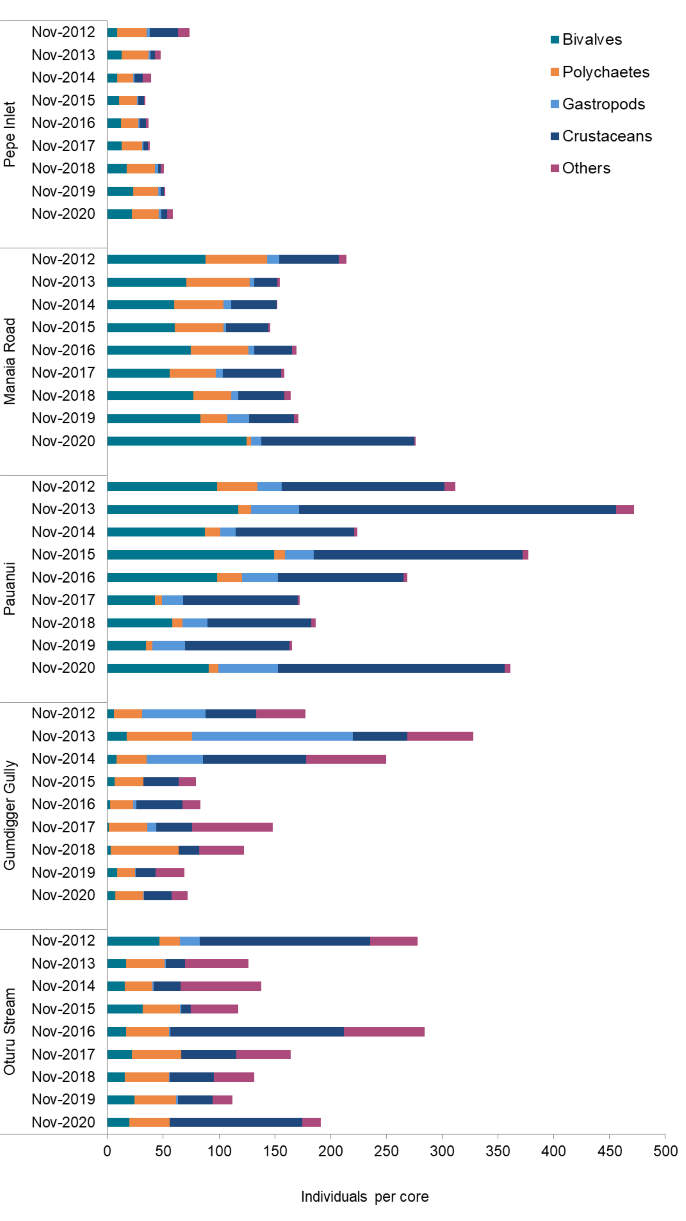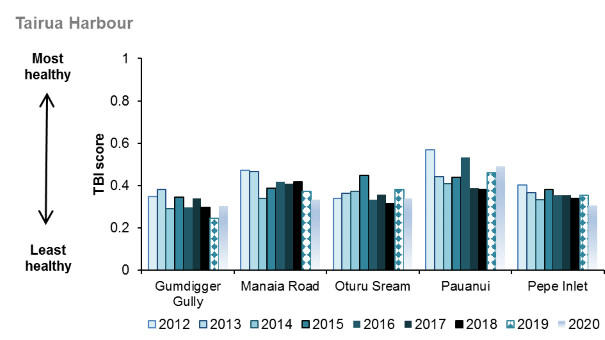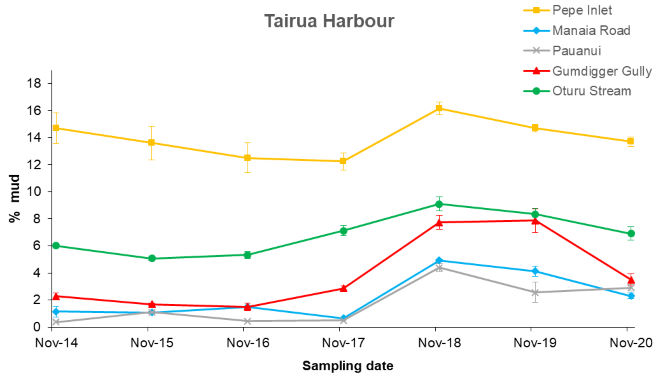Tairua Harbour - estuary monitoring results
Sediment-dwelling organisms
The sediment-dwelling organism community in Tairua Harbour is made up of a broad range of taxa groups, bivalves and polychaetes are not as dominant as they are in Firth of Thames and Whaingaroa (Raglan) Harbour. Crustaceans are a lot more abundant in Tairua Harbour, in particular isopods (sea woodlice) and amphipods (shrimp like crustaceans). Other taxa and gastropods are also relatively abundant. The composition of the sediment-dwelling organism community is relatively consistent at each site, whereas the total abundance of individuals each year varies at some sites.
The three northern sites differ in their taxa composition and abundance. At Pepe Inlet, the abundance of sediment-dwelling organisms is the lowest of all monitoring sites. Here polychaetes (Ragworms – nereidids, Scoloplos cylindrifer) are consistently more abundant than bivalves. Crustaceans are relatively abundant and gastropods are found in low numbers.
Manaia Road and Pauanui (which are close together but on opposite sides of the main harbour channel) organism communities have similar taxa groups, but they differ in abundance. Bivalves (cockles -Austrovenus stutchburyi) are abundant at both sites, with crustaceans (isopods, amphipods, barnacles) being the dominant taxa group and more abundant at Pauanui. Gastropods (Zeacumantus subcarinatus and limpets - Notoacmea spp.) are also more abundant at Pauanui. Polychaetes (Aonides trifida) are more abundant at Manaia Road and the second most abundant group. The total abundance of individuals varies more at Pauanui compared to Manaia Road.
The two southern upper sites, Gumdigger Gully and Oturu Stream are different from the other sites in terms of composition. The two most abundant taxa groups overall at these sites are crustaceans (isopods and amphipods) and others (oligochaetes). Gastropods (Potamopyrgus spp.) are also relatively abundant at Gumdigger Gully but not consistently. There is more variation in total abundance of individuals each year at Gumdigger Gully and Oturu Stream compared to the other sites.
A detailed analysis of all trends in our results as well as the relationships between sediment properties and sediment-dwelling communities are investigated in our latest trend report.

Estuarine health indicator
An estuarine health index called the Traits Based Index (TBI) is used to track the health of our estuary sites over time, and to compare the health of different estuaries. It ranges between zero and one, with one being most healthy and zero being least healthy. The TBI is calculated based on the presence of different species or organisms at a site and uses biological traits (e.g. body size, mobility, feeding behaviour). Sites in Tairua Harbour were moderately healthy (having a TBI score between 0.3 and 0.6). There were differences between sites. Pauanui and Manaia Road had slightly higher TBI scores (indicating a healthier environment) than those at Pepe Inlet, Gumdigger Gully and Oturu Stream.
More detailed information on the TBI can be found on the coastal biology indicator webpage.

Sediment properties
We measure sediment properties (including total organic carbon, total nitrogen, chlorophyll a, phaeophytin and grain size) at our monitoring sites and investigate if they are changing over time. Changes could indicate responses to mechanical disturbance, changes to water quality or the introduction of terrestrial sediment and contaminants. One important property we measure is grain size. If the intertidal flats are exposed to increasing sediment run-off from the catchment or other sources of fine sediment, the proportion of smaller grain sizes such as mud increases. This can create an unsuitable habitat for some sediment-dwelling animals.
The graph below shows the average (± standard error) sediment mud content (%) at each monitoring site between 2014 and 2020. The standard error is a measure of how accurate the average is. In Tairua Harbour the mud content was highest at Pepe Inlet (average 14%) and on average less than 5% at Manaia Road, Pauanui and Gumdigger Gully. Overall the mud content was relatively consistent between 2014 and 2020.
A full analysis of grain size and other sediment properties can be found in our latest trend report.



To ask for help or report a problem, contact us
Tell us how we can improve the information on this page. (optional)